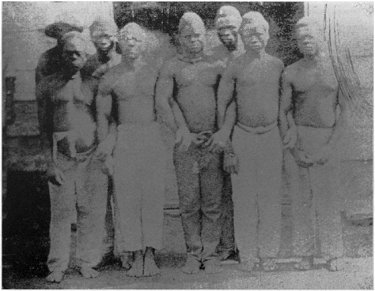History of Latin America
Africans in Colonial Latin America
Lecture outline

“African workers of the Canal de Vento,” a picture taken by French doctor Henri Dumont in the 1860s in Cuba.
These men were probably captured on slave ships, then nominally freed by the Spanish and forced to labor on public works.
Rebecca J. Scott, Slave Emancipation in Cuba : The Transition to Free Labor, 1860-1899 (Princeton University Press, 1985).
Want to learn more about the Atlantic slave trade in Latin America and the Caribbean,
and also slavery in other places and times?
Check out this sweeping, open source Handbook of Global Slavery
**********
Maroon (from the Spanish cimarrón) communities of Afro-descendants who escaped slavery survive today as communities of memory, sometimes as towns originally incorporated by the colonial state.
Others became so powerful that they were ultimately destroyed, like Palmares in Brazil.
In much of Spanish and Portuguese America, free blacks and people of African descent
matched or outnumbered the African enslaved population.
What different ideas about blackness and whiteness might exist in a slave society that included
large numbers of free black people engaged in a huge range of occupations--
As opposed to one in which being 'black' generally meant being enslaved?
| Country | Enslaved | Free Blacks | Percent Free | |
|---|---|---|---|---|
| Spanish | ||||
Panama | 3,500 | 33,000 | 90% | |
| Cacao zone of Ven.: | 64,000 | 198,000 | 76% | |
| New Granada: | 80,000 | 420,000 | 84% | |
| Santo Domingo: | 15,000 | 80,000 | 84% | |
Portuguese
| ||||
| Minas Gerais, Brazil | 40.9% | 33.7% | ||
| Bahia, Brazil | 47% | 31.6% | ||
| Pernambuco, Brazil | 26.2% | 42% | ||
| Brazil overall | 34.5% | 31.4% | ||
| Non-Iberian | ||||
| Haiti (Saint Dominique)/ Martinique/Guadeloupe, combined: | 575,000 | 30,000 | 5% | |
| USA in 1790: | 660,000 | 32,000 | 4.6% | |